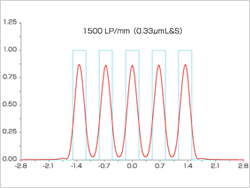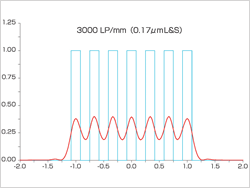2. Resolución espectral de los microscopios de escaneo láser
2-1. CTF (Contrast Transfer Function)
The plane resolving power of typical optical microscopes is generally defined by Rayleigh's resolving power. Even if the optical system is aplanatic, when projecting an infinitely small point with the optical system the projected image spreads due to diffraction. This spread is called the PSF (point spread function) and is determined by the wavelength used and the NA (numerical aperture) of the optical system. The radius where the strength becomes 0 for the first time from the center (first dark ring) is calculated by 0.61 × λ / NA. According to Rayleigh's definition, the resolving power of two adjacent points is defined as the state where the center of one PSF is positioned on the first dark ring of the other PSF. The reflective confocal laser scanning microscope has what is called coherent image formation, and its image formation principles are different from common microscopes. For this reason Rayleigh's definition of resolving power cannot be used to directly compare the performance of laser scanning microscopes with ordinary optical microscopes. Therefore, the CTF (contrast transfer function) is used for evaluation. The CTF evaluates the image contrast against the space frequency. However, unlike the MTF (modulation transfer function), the CTF evaluates the propagation of contrast made by rectangular waves 0 and 1 that have the same width, but reflectance 1 (100%) and reflectance 0 (0%). Figure 5 is a simulation example of image shading obtained from a monochrome pattern with different pitches. You can see that the contrast becomes less clear as the pitch gets smaller. Laser scanning microscopes realize clearer contrast at all space frequencies than ordinary optical microscopes though the cut-off frequency is not dramatically improved (details about this are beyond the scope of this document). This means that the space frequency to obtain the same contrast is higher, indicating that observation with a higher space resolving power is effectively possible. It is needless to say that lasers with a short wavelength and objective lenses with a large NA must be used to improve the resolving power of laser scanning microscopes, as with ordinary optical microscopes. In addition, not only the principles but also the completeness of the product is an important element. For example, the spherical aberration of an optical system, the jitter of a scanning mechanism, and the light after passing through the pinhole are detected as electrical signals. Therefore, observation with a higher resolving power becomes possible if all of these elements including electrical S/N are in the proper conditions.
| Figure 5: Contrast Comparison | |
 |  |
- 1. Basic Principles of Laser Scanning Microscopes
- 2. Resolving Power of Laser Scanning Microscopes
- 3. Measurement Accuracy of Laser Scanning Microscopes
- 4. Software for Laser Scanning Microscopes
- 5. Basic Features of Olympus Industrial Laser Scanning Microscopes
- 6. Application Examples
> Click here for detail about OLS5000, laser confocal microscopes
> Click here for detail about OLS4500, nano search microscopes